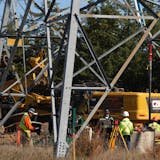A team of financial consultants hired by the state of Minnesota says its doubtful that PolyMet Mining Corp. can come up with the hundreds of millions of dollars necessary to protect taxpayers against long-term environmental risks from its proposed copper-nickel mine.
And, they say in a report filed with the state, there is no certainty that PolyMet will find the deep pockets it will need.
That assessment comes at a critical time for PolyMet's proposed $650 million open-pit mine near Hoyt Lakes. As the proposal moves into its next state-permitting phase, state regulators are wrestling with how to cement a financial agreement to protect Minnesota taxpayers from the risks inherent in copper mining — catastrophic accidents, mine closure and water treatment that could last for hundreds of years.
The process is under intense scrutiny from advocates on both sides of the most divisive environmental issue that state regulators have tackled in years, as well as Gov. Mark Dayton, who has called this decision among the most difficult he makes as governor.
The consultants' report underscores the fine line Minnesota must walk in the coming months. If it asks for too little from PolyMet, state taxpayers and the people downstream from the mine could pay the price — tens of millions of dollars in future cleanup costs. If it asks for too much, a long-awaited project seen as an economic boon to the Iron Range could be stopped in its tracks.
PolyMet officials said the final number has yet to be negotiated, but the company has proposed setting aside $332 million for financial assurance.
At this point the state doesn't have a number, said Barbara Naramore, assistant commissioner at the Minnesota Department of Natural Resources, and its consultants haven't yet furnished an estimate of their own. Naramore said agency officials understand that the decision could have significant financial implications for PolyMet.
"But we need to look at it through the lens of making sure the state's interests are protected," she said.


